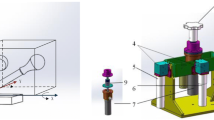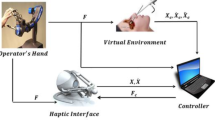Abstract
This paper explores the use of a 2-D (Direct-Drive Arm) manipulator for mechanism design applications based on virtual reality (VR). This article reviews the system include a user interface, a simulator, and a robot control scheme. The user interface is a combination of a virtual clay environment and human arm dynamics via robot effector handler. The model of the VR system is built based on a haptic interface device behavior that enables the operator to feel the actual force feedback from the virtual environment just as s/he would from the real environment. A primary stabilizing controller is used to develop a haptic interface device where realistic simulations of the dynamic interaction forces between a human operator and the simulated virtual object/mechanism are required. The stability and performance of the system are studied and analyzed based on the Nyquist stability criterion. Experiments on cutting virtual clay are used to validate the theoretical developments. It was shown that the experimental and theoretical results are in good agreement and that the designed controller is robust to constrained/unconstrained environment.
Similar content being viewed by others
References
Adams, R. and Hannaford, B.: Stable haptic interaction with virtual environments, IEEE Trans. Robotics Automat. 15(3) (1999), 465–474.
An, H. C., Atkeson, G. C., and Hollerbach, M. J.: Model-Based Control of Robot Manipulator, MIT Press, Cambridge, MA, 1988.
Asada, H. and Slotine, J. E.: Robot Analysis and Control, Wiley, New York, 1986.
Bejczy, A. K., Bekey, G., and Lee, S. K.: Computer control of space borne teleoperators with sensory feedback, in: IEEE Conf. on Robotics and Automation, 1985.
Burdea, G. C.: Force and Touch Feedback for Virtual Reality, Wiley, New York, 1996.
Chu, C.-C., Dani, T., and Gadh, R.: Multimodal interface for a virtual reality based computer aided design system, in: Proc. of 1997 IEEE Internat. Conf. on Robotics and Automation, Albuquerque, NM, April 1997, pp. 1329–1334.
Hamada, T., Kamejima, K., and Takeuchi, I.: Image based operation; A human-robot interaction architecture for intelligent manufacturing, in: Proc. of IECON, 1989, pp. 556–561.
Hannaford, B.: A design framework for teleoperators with kinematic feedback, in: IEEE Internat. Conf. on Robotics and Automation, Vol. 5, No. 4, August 1989.
Her, M. G., Hsu, K. S., Yu, W. S. and Karkoub, M.: Analysis and design of haptic telerobotic system, IEE Proc. Control Theory Appl. 148(4) (2001), 306–314.
Hirata, Y. and Sato, M.: 3-dimensional interface device for virtual work space, in: Proc. of the IEEE/RSJ Internat. Conf. on Intelligent Robots and Systems, Raleigh, NC, USA, 1992, pp. 889–896.
Kazerooni, H. and Her, M. G.: The dynamics and control of a haptic interface device, IEEE Trans. Robotics Automat. 10(4) (1994), 453–464.
Kraftcheck, J., Dani, T., and Gadh, R.: State of the art in virtual design and manufacturing, VR News (1997), 16–20.
Lee, S., Bekey, B., and Bejczy, A. K.: Computer control of space-borne teleoperators with sensory feedback, in: Proc. of the 1985 IEEE Internat. Conf. on Robotics and Automation, 1985, pp. 205–214.
Minsky, M. and Ouh-young, M.: Feeling and seeing: Issues in force display, Comput. Graph 24(2) (1990), pp. 235–243.
Rack, P.M. and Westbury, D. R.: Elastic properties of the cat soleus tendon and their functional importance, J. Physiol. 347 (1984), 479–495.
Raju, G. J., Verghese, G. C., and Sheridan, T. B.: Design issues in network models of bilaterial remote manipulation, in: IEEE Internat. Conf. on Robotics and Automation, Scottsdale, AZ, May 1989.
Repperger, D. W. and Morris, A.: Discriminant analysis of changes in human muscle function when interacting with an assistive aid, IEEE Trans. Biomed. Engrg. 35 (May 1988).
Reznik, D. and Laugier, C.: Dynamic simulation and virtual control of a deformable fingertip, in: IEEE Internat. Conf. on Robotics Automation, Minneapolis, MN, April 1996, pp. 1669–1674.
Satoshi, K. and Hidetomo, T.: Modeling and NC programming for free-form surfaces by haptic interfaces, in: The 1996 ASME Design Engineering Technical Conf. and Computer in Engineering Conf., Irvine, CA, 18–22 August 1996.
Sawada, H. and Hashimoto, S.: Haptic device driven by grasping force for hand gesture telecommunication, in: ASME, Dynamic Systems and Control Division, NJ, USA, 1999, Vol. 67, pp. 437–444.
Sheridan, T. B. and Ferrell, W. R.: Man-Machine Systems: Information, Control, and Decision, Models of Human Performance, MIT Press, Cambridge, MA, 1974.
Walairacht, S., Ishii, M., Koike, Y., and Sato, M.: Two-handed multi-figers string-based haptic interface device, IEICE Trans. Inform. Systems E84-D(3) (March 2001), 365–373.
Author information
Authors and Affiliations
Rights and permissions
About this article
Cite this article
Her, MG., Hsu, KS., Lan, TS. et al. Haptic Direct-Drive Robot Control Scheme in Virtual Reality. Journal of Intelligent and Robotic Systems 35, 247–264 (2002). https://doi.org/10.1023/A:1021156903545
Issue Date:
DOI: https://doi.org/10.1023/A:1021156903545




